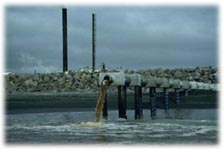 |
 |
|
|||
 |
|||
 |
|
Pollution Research has lagged behind industrial development, and the environmental effects of introducing such a large number of new compounds are still poorly understood. Many of these pollutants are being distributed globally, and can enter the New Zealand marine environment through air and water currents. The Trust has done its bit by collecting samples from dead whales and dolphins, killed in fishing gear or found dead on a beach. These samples have been analysed by pollution experts, including Dr Paul Jones (formerly at Environmental Science and Research in Wellington, currently at the Aquatic Toxicology Laboratory, Michigan State University, USA). Several human-made compounds have been found in Hector’s dolphin tissues, including DDTs, PCBs, dioxins and other toxins. Levels are not as high as in marine mammals from more densely populated areas (e.g. Europe, Japan). However, pollutant levels are noticeably higher in coastal marine mammals, especially Hector’s dolphins, than in offshore species like minke and blue whales. These pollutant levels make Hector’s dolphins arguably the most contaminated animal in New Zealand. For a species struggling to hold its own, this is the last thing it needs. Publications and reports |
For a list of general Trust associated publications and reports on marine mammals and marine mammal ecology, click here. To find out about the people iinvolved in this research, see the Univerisity of Otago Marine Mammal Research Group web site. |
